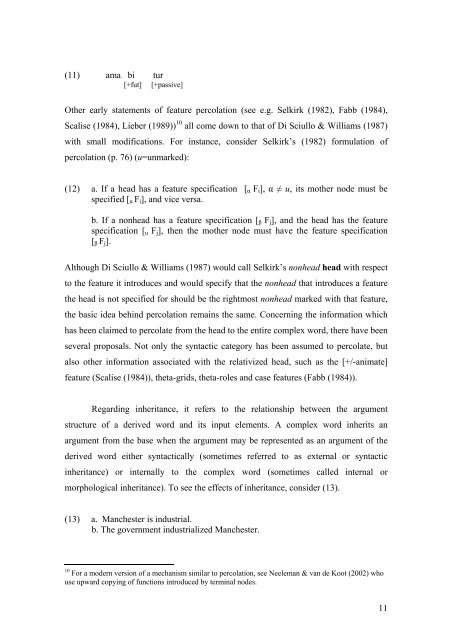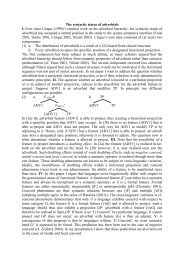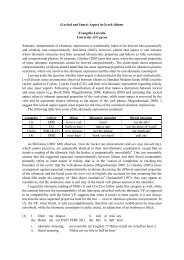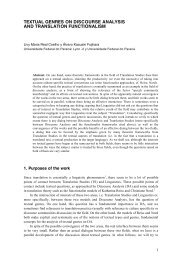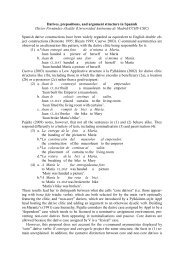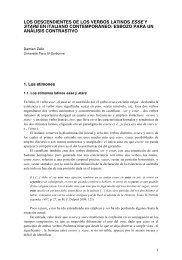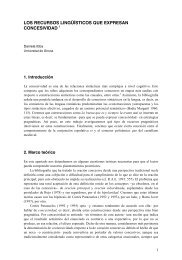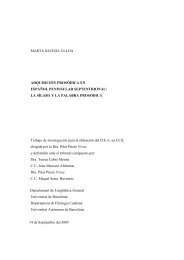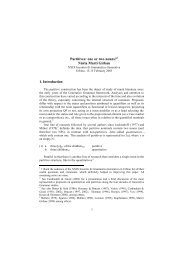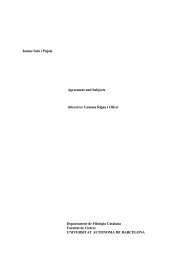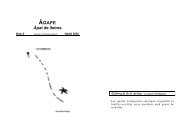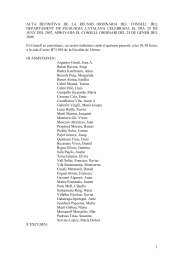Prefixation in English and Catalan - Departament de Filologia ...
Prefixation in English and Catalan - Departament de Filologia ...
Prefixation in English and Catalan - Departament de Filologia ...
You also want an ePaper? Increase the reach of your titles
YUMPU automatically turns print PDFs into web optimized ePapers that Google loves.
(11) ama bi tur<br />
[+fut] [+passive]<br />
Other early statements of feature percolation (see e.g. Selkirk (1982), Fabb (1984),<br />
Scalise (1984), Lieber (1989)) 10 all come down to that of Di Sciullo & Williams (1987)<br />
with small modifications. For <strong>in</strong>stance, consi<strong>de</strong>r Selkirk’s (1982) formulation of<br />
percolation (p. 76) (u=unmarked):<br />
(12) a. If a head has a feature specification [α Fi], α ≠ u, its mother no<strong>de</strong> must be<br />
specified [α Fi], <strong>and</strong> vice versa.<br />
b. If a nonhead has a feature specification [β Fj], <strong>and</strong> the head has the feature<br />
specification [u Fj], then the mother no<strong>de</strong> must have the feature specification<br />
[β Fj].<br />
Although Di Sciullo & Williams (1987) would call Selkirk’s nonhead head with respect<br />
to the feature it <strong>in</strong>troduces <strong>and</strong> would specify that the nonhead that <strong>in</strong>troduces a feature<br />
the head is not specified for should be the rightmost nonhead marked with that feature,<br />
the basic i<strong>de</strong>a beh<strong>in</strong>d percolation rema<strong>in</strong>s the same. Concern<strong>in</strong>g the <strong>in</strong>formation which<br />
has been claimed to percolate from the head to the entire complex word, there have been<br />
several proposals. Not only the syntactic category has been assumed to percolate, but<br />
also other <strong>in</strong>formation associated with the relativized head, such as the [+/-animate]<br />
feature (Scalise (1984)), theta-grids, theta-roles <strong>and</strong> case features (Fabb (1984)).<br />
Regard<strong>in</strong>g <strong>in</strong>heritance, it refers to the relationship between the argument<br />
structure of a <strong>de</strong>rived word <strong>and</strong> its <strong>in</strong>put elements. A complex word <strong>in</strong>herits an<br />
argument from the base when the argument may be represented as an argument of the<br />
<strong>de</strong>rived word either syntactically (sometimes referred to as external or syntactic<br />
<strong>in</strong>heritance) or <strong>in</strong>ternally to the complex word (sometimes called <strong>in</strong>ternal or<br />
morphological <strong>in</strong>heritance). To see the effects of <strong>in</strong>heritance, consi<strong>de</strong>r (13).<br />
(13) a. Manchester is <strong>in</strong>dustrial.<br />
b. The government <strong>in</strong>dustrialized Manchester.<br />
10 For a mo<strong>de</strong>rn version of a mechanism similar to percolation, see Neeleman & van <strong>de</strong> Koot (2002) who<br />
use upward copy<strong>in</strong>g of functions <strong>in</strong>troduced by term<strong>in</strong>al no<strong>de</strong>s.<br />
11


